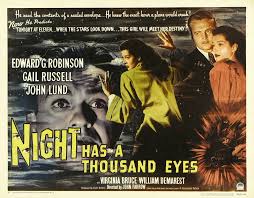“Night Has a Thousand Eyes” (1948)
Drama

Running Time: 81 minutes
Written by: Barré Lyndon and Jonathan Latimer
Directed by: John Farrow
Featuring: Edward G. Robinson, Gail Russell and John Lund
John Triton aka ‘The Mental Wizard’: “I’d become a sort of a reverse zombie. I was living in a world already dead, and I alone knowing it.”
“Night Has a Thousand Eyes” is a captivating psychological thriller that delves deep into the realms of premonition, fate, and the human psyche. Directed by John Farrow and released in 1948, this film is based on Cornell Woolrich’s novel of the same name, and it brings to life a haunting tale that keeps viewers on the edge of their seats from start to finish.
The film follows the enigmatic figure of John Triton, played masterfully by Edward G. Robinson, who possesses the uncanny ability to foresee tragic events before they occur. Triton’s eerie gift torments him, isolating him from society and driving him to the brink of madness. His premonitions, depicted in hauntingly surreal sequences, create an atmosphere of tension and dread that permeates the entire film.
Robinson’s portrayal of Triton is nothing short of mesmerizing. He captures the character’s torment and internal conflict with remarkable depth, drawing viewers into Triton’s world of uncertainty and fear. Robinson’s performance is the heart of the film, anchoring its emotional core and elevating it to a level of cinematic brilliance.
Supporting Robinson is a stellar cast including Gail Russell as the love interest, Jean Courtland, and John Lund as her skeptical fiancé, Elliott Carson. Russell brings a sense of vulnerability and innocence to her role, while Lund provides a strong foil to Robinson’s troubled protagonist. Their interactions with Triton add layers of complexity to the narrative, as they grapple with the implications of his premonitions and their own beliefs about fate and destiny.
Visually, “Night Has a Thousand Eyes” is a feast for the eyes. Cinematographer John F. Seitz creates a noir-infused atmosphere with his use of shadow and light, evoking a sense of foreboding that mirrors Triton’s own inner turmoil. The film’s moody visuals are complemented by a haunting score composed by Victor Young, which further enhances the sense of unease that permeates every frame.
At its core, “Night Has a Thousand Eyes” is a meditation on the nature of fate and the power of belief. It raises thought-provoking questions about the existence of destiny and the extent to which we can control our own lives. Through Triton’s journey, the film explores themes of guilt, redemption, and the search for meaning in a seemingly indifferent universe.
“Night Has a Thousand Eyes” unfolds with a sense of inevitability, drawing viewers into a web of intrigue and suspense that grips them until the final frame. The pacing is deliberate yet gripping, allowing the tension to build gradually as Triton’s premonitions become increasingly frequent and intense. Each prediction serves as a breadcrumb leading towards a shocking revelation, keeping audiences guessing until the very end.
One of the film’s most compelling aspects is its exploration of the psychological toll of Triton’s gift. As he grapples with the burden of knowing the future, he becomes consumed by paranoia and despair. His isolation from society mirrors his inner turmoil, highlighting the alienating effects of his extraordinary abilities. Through Triton’s character arc, the film delves into the complexities of human nature and the fragile line between sanity and madness.
The dynamic between Triton and Jean Courtland adds an additional layer of depth to the narrative. Their burgeoning romance is fraught with tension, as Triton’s premonitions cast a shadow over their relationship. Jean’s unwavering faith in Triton’s abilities serves as a source of both comfort and conflict, highlighting the complexities of trust and belief in the face of uncertainty.
Furthermore, “Night Has a Thousand Eyes” is notable for its exploration of moral ambiguity. As Triton grapples with the consequences of his visions, he is forced to confront the ethical implications of altering the course of fate. His internal struggle raises thought-provoking questions about the nature of free will and the responsibility that comes with knowledge of the future.
The film’s climax is nothing short of breathtaking, as Triton’s premonitions culminate in a heart-pounding sequence that delivers on the promise of suspense and intrigue. The resolution is both satisfying and thought-provoking, leaving viewers pondering the deeper themes long after the credits roll.
In addition to its thematic depth, “Night Has a Thousand Eyes” is a technical marvel. The film’s noir-inspired cinematography and atmospheric lighting create a sense of unease that permeates every frame. From shadowy alleyways to dimly lit interiors, the visual composition is masterfully crafted to evoke a sense of dread and uncertainty.
While “Night Has a Thousand Eyes” may not enjoy the same level of recognition as other classic thrillers of its time, such as “Double Indemnity” or “The Maltese Falcon,” it nonetheless stands as a testament to the enduring power of storytelling. With its atmospheric visuals, stellar performances, and thought-provoking themes, this film continues to captivate audiences nearly seven decades after its initial release. For fans of classic cinema and psychological thrillers alike, “Night Has a Thousand Eyes” is not to be missed.
Special Features
- 1080p High-definition presentation on Blu-ray
- NEW Audio Commentary with critic Imogen Sara Smith
- NEW The Author’s Prerogative: Biographer Marilyn Ann Moss on John Farrow’s Films (and the Life That Made Them) (2024)
- Screen Directors Playhouse: Night Has A Thousand Eyes – radio version (1949)
- Theatrical Trailer
- Audio LPCM 2.0 Mono
- Original Aspect Ratio 1.33:1






